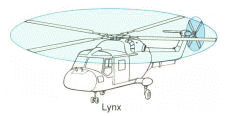 The main rotor and tail rotor configuration is used on an A‚rospatiale/Westland
Lynx.
The main rotor and tail rotor configuration is used on an A‚rospatiale/Westland
Lynx. |
The rotors on a helicopter can be configured in several ways. The most
common configuration is the combination of one main rotor and one tail rotor.
The tail rotor compensates for the torque that is produced by the main rotor.
The tail rotor also controls the helicopter along the vertical axis during
hover flight. |
| The tandem rotor (or twin-rotor) configuration is used mainly with large
helicopters. Because of the opposite rotation of the rotors, the torque
of each single rotor is neutralized. The construction of the control system
is much more complicated compared to a helicopter with a tail rotor. The
arrangement of two rotors side by side was never very popular. This design
was used for the largest helicopter ever built—the Mil Mi-12. The
Piasecki helicopters also use tandem rotors—one toward the front of
the helicopter and one at its rear. |
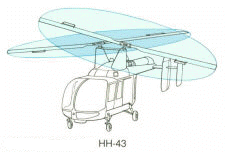
The Kaman HH-43 uses two intermeshing rotors. |
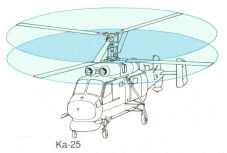
A coaxial rotor is found on the Kamov Ka-25. |
The twin-rotor synchropter is a system with two rotors that mesh into
each other, much like a gearwheel. Like the tandem rotor, this configuration
doesn't need a tail rotor because the torque is compensated for by the opposite
rotation of the rotors. This system was developed during the early days
of helicopter flying but fell into disuse. |
| Today, this kind of rotor arrangement has been rediscovered and is used
with the Kaman K-MAX, a single seat helicopter mainly used for external
load transportation. |
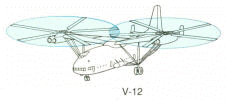 The Mil Mi-12 (V-12) uses side-by-side tandem rotors.
The Mil Mi-12 (V-12) uses side-by-side tandem rotors. |
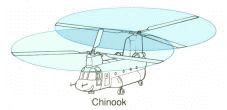 Tandem rotors (fore and aft) are found on the Boeing Vertol CH-47 Chinook.
Tandem rotors (fore and aft) are found on the Boeing Vertol CH-47 Chinook.
|
The last configuration is the coaxial rotor. One rotor is located on top
of the other. The two rotors turn in opposite directions. Depending on which
rotor produces more lift, the helicopter will turn to the left or right,
because of the torque. Helicopters with this configuration cannot reach
a high cruising speed because the drag is too large. Only after the development
of the rigid rotor was it possible to build the two rotors closer together
and reduce the drag considerably. This configuration has been chosen mainly
by Russian Kamov helicopters. |



